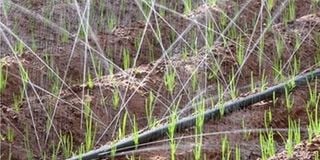Where to find innovative, affordable rain hose irrigation kits
Sponsored by Grekkon

Grekkon rain hose
Farmers looking for innovative, affordable, easy to install and maintain irrigation solutions now have an option in Grekkon Limited’s rain hose pipes.
Having pioneered this technology, Grekkon Limited is the leading supplier and installer of rain hose irrigation kits in East Africa.
Rain hose systems are a new way of watering crops intensely under moderate pressure using a pump.
Nanotechnlogy inspired
A high-density polyethylene (HDPE) pipe is the main accessory of the rain hose irrigation kit. The pipe, measuring 50 or 100 metres long, is sequentially punctured along its width at determined intervals using Nanotechnology to create tiny holes from which crops are irrigated.
Nanotechnology manipulates matter at extremely small or minutes sizes, called nanometres, to make highly functional products.
Feted
In 2019, farmers voted Grekkon Ltd as the “Most Preferred Irrigation Systems Company in Kenya” during the prestigious annual Agribusiness Excellence Awards.
This made the three-year-old irrigation and greenhouse systems firm the first and only start-up to ever win this award.
Easy to install
Rain hose irrigation kits are easy to install and use. They are cheaper than drip irrigation kits, but have a similar lifespan.
Components
Other than a pipe, a rain hose kit comprises other components that make it functional. End caps are placed at the end of the pipe to retain water in the system. Starter off-takes or mini valves connect the rain hose pipe to the main water line, while pipe connectors link two rain hose pipes.
The pipes have different diameters, ranging from 32 to 50 millimetres. Farmers choose the preferred size based on the crop’s water needs and the size of the area to be irrigated. For instance, a farmer who has planted an acre will comfortably water the field with the volume delivered through a 32mm rain hose pipe. Another grower with five acres needs a 50mm rain hose pipe.
Pricing
Grekkon Limited supplies the rain hose irrigation kits at these prices at Ksh3,500 for one with 32mm or one-inch diameter hose; Ksh4,500 for a 40mm or one-and-a-quarter inch diameter hose; and Ksh5,500 for a 50mm or one-and-a-half-inch diameter hose.
Performance
The system requires a pressure head of 30 metres.
The rate of water discharge is determined by the size of the diameter. The system irrigates in opposite directions at varying radii: 3m for the 32mm pipe; 5m for the 40mm pipe and; 7m for the 50mm pipe. The height of the water jet is about a metre.
Assembling the kit
First, lay the main line. This is the pipe delivering irrigation water to the farm from the pump. Your mainline will be larger in size than the rain hose pipe. So if your rain hose pipe is one inch, for instance, use a 1.5 or two-inch main or sub-main line.
Secondly, connect the pipe to the main line. Make a one-inch insertion on the mainline and attach the off-take connector. The size of the insertion is as per the size of your off-take.
Thirdly, attach the rain hose pipe to the off-take connector. Finally, insert the end cap at the end of the hose.
Where to use the system
This irrigation system can be used in crop nurseries for vegetables, fruits or forestry. It can also be used in irrigating short vegetable crops (knee-high and below) such as cabbage, lettuce, broccoli, kales, spinach, collards, broad beans, carrot, strawberry and others, or pasture, grass and legumes.
When choosing the crop to irrigate using this method, consider its susceptibility to foliage fungal infections. This is predisposed by leaf surface wetness.
Tomato, potato, peppers, peas, green beans and chili easily succumb to foliage fungal infections when overhead or a rain hose system is used for a long time.
To learn more, visit https://grekkon.com/rain-hose-irrigation/


